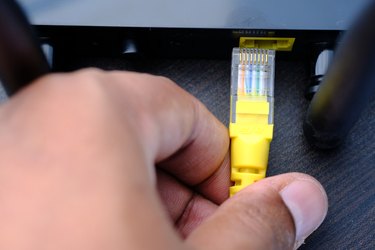
If you have internet service in your home or office from a cable company, you'll likely connect to the internet provider's network using coaxial cables. Since computers and other digital devices don't typically have input jacks for these cables, you'll need to convert coax to Ethernet or wireless signals. Most cable modems and combination router-modems you get from a cable company can do the job. You can also get adapters to let you use coaxial cable for internet within your building, converting to Ethernet when needed.
How to Define Coax
Video of the Day
Coaxial cable, sometimes abbreviated coax, is a type of wire used to deliver cable TV, internet and other services. It typically looks like a single wire with a metal piece in the middle and a round, screw-on connector. If you have cable boxes or a cable modem in your home or office, they're likely connected to cable jacks using coaxial cable.
Video of the Day
You can buy coaxial cable at electronics stores or hardware stores, order it online or get some from your cable company. If you need to connect multiple devices to one cable jack, you can get a cable splitter, which takes one cable as input and sends the same signal to multiple output cables. Using too many splitters can impact the quality of your signal, however, so you may want to ask your cable company for assistance if you need to connect more devices than you have jacks.
How Ethernet Works
Ethernet is a decades-old standard for networking computers together to share internet resources, files, printers and other resources. Different versions of the Ethernet standard allow for connections at different speeds and with different properties, and Ethernet connections are typically built using cables that resemble traditional landline phone cords.
Many desktop and laptop computers have Ethernet jacks that enable them to connect to Ethernet networks. Routers and other pieces of network equipment also often feature Ethernet jacks. Homes and offices sometimes include Ethernet jacks run discreetly within walls or below phones or carpets to connect devices without a mess of cables.
More recently, Wi-Fi connections have replaced Ethernet for some applications, but wired connections can still be speedier and less prone to interference, making them advantageous for some applications that require fast connections, such as video gaming, or the transference of lots of data, such as video editing.
Using Ethernet and Coaxial Cable
Most cable modems that you get from a cable company or purchase on your own take input in the form of coaxial cable and allow other devices to connect via an Ethernet connection. Some modern modems are also wireless routers, meaning that they also allow devices to connect via a Wi-Fi connection, and other modems can be hooked up to a wireless router using an Ethernet cable.
Often, when you first sign up for cable internet service, the installation technician will connect the modem to the wall with a coaxial cable and provide Ethernet cables for connecting routers or other devices directly to the modem. If you install your modem yourself, you can do the same by following the instructions to connect the coaxial cable and Ethernet cable in the appropriate places.
In some cases, you can also send an internet signal within your house or workplace through coaxial cables you already have installed for television service. This will let you get the benefits of a wired connection in multiple rooms without having to install new cabling. You can buy a cable-to-Ethernet adapter to allow devices with Ethernet jacks to connect to such a network.
Your cable company or a private IT may be able to help you set up your home or office network this way, though you may have to pay for the service.